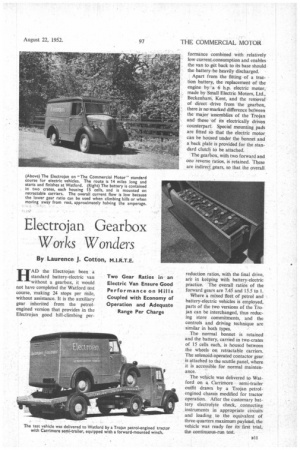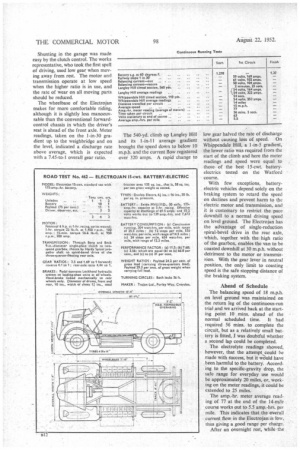Electrojan Gearbox Works Wonders
Page 45

Page 46

Page 47

If you've noticed an error in this article please click here to report it so we can fix it.
By Laurence J. Cotton, M.I.R.T.E.
HAD the Electrojan been a standard battery-electric van without a gearbox, it would not have completed the Watford test course, making 24 stops per mile, without assistance. It is the auxiliary gear inherited from the petrolengined version that provides in the Electrojan good hill-climbing per
reduction ratios, with the final drive, are in keeping with battery-electric practice. The overall ratios of the forward gears are 7.45 and 15.5 to I.
Where a mixed fleet of petrol and battery-electric vehicles is employed, parts of the two versions of the Trojan can be interchanged, thus reducing 'store commitments, and the controls and driving technique are similar in both types.
The normal bonnet is retained and the battery, carried in two-crates of 15 cells each, is housed between the wheels on retractable carriers. The solenoid-operated contactor gear is attached to the scuttle panel, where it is accessible for normal maintenance.
The vehicle was delivered to Watford on a Carrimore semi-trailer outfit drawn by a Trojan petrolengined chassis modified for tractor operation. After the customary battery electrolyte check, connecting instruments in appropriate circuits and loading to the equivalent of three-quarters maximum payload, the vehicle was ready for its' first trial, the continuous-run test. Shunting in the garage was made easy by the clutch control. The works representative, who kook the first spell of driving, used low gear when moving away from rest. The motor and transmission operate at low speed when the higher ratio is in use, and the rate of wear on all moving parts should be reduced.
The wheelbase of the Electrojan makes for more comfortable riding, although it is slightly less manoeuvrable than the conventional forwardcontrol chassis in which the driver's seat is ahead of the front axle. Meter readings, taken on the 1-in-30 gradient up to the weighbridge and on the level, indicated a discharge rate above average, which is expected with a 7.45-to-1 overall gear ratio. The 540-yd. climb up Langley Hill and its 1-in-11 average gradient brought the speed down to below 10 m.p.h. and the current flow registered over 320 amps, A rapid change to low gear halved the rate of discharge without causing loss of speed. On Whippendale Hill, a 1-in-5 gradient, the lower ratio was required from the start of the climb and here the meter readings and speed were equal to those of the best 15-cwt, batteryelectries tested on the Watford course.
With few exceptions, batteryelectric vehicles depend solely on the braking system to retard the speed on declines and prevent harm to the • electric motor and transmission, and it is customary to restrict the pace downhill to a normal driving speed on level ground. The Electrojan has the advantage of single-reduction spiral-bevel drive in the rear axle, which, together with the high ratio of the gearbox, enables the van to be coasted downhill at 30 m.p.h. without detriment to the motor or transmission. With the gear lever in neutral position, the only limit to coasting speed is the safe stopping distance of the braking system.
Ahead of Schedule
The balancing speed of 18 m.p.h. on level ground was maintained on the return leg of the continuous-run trial and we arrived back at the starting point 10 mins. ahead of the normal scheduled time, it had required 56 ruins, to complete the circuit, but as a relatively small battery is fitted, I was doubtful whether a second lap could be completed.
The electrolyte readings showed, however, that the attempt could be made with Success, but it Wsould have been harmful to the battery. According to the specific-gravity drop, the safe range for everyday use would be approximately 20 miles, or, working on the meter readings, it could be extended to 25 miles.
The amp.-hr. meter average reading of 77 at the end of the 14-mile course works out to 5.5 amp.-hrs. per mile. This indicates that the overall current flow in the Eiectrojan is low, thus giving a good range per charge.
After an overnight rest, while the
battery was being recharged, the vehicle was in good condition for the 12-stop-per-mile test, the electrolyte and volt-meter readings being on the top limit. The first three M115S Of this test were made without stops, apart from any caused by traffic in the town, and as further proof of its speed, the van averaged 15 m.p.h. to the first scheduled " delivery point."
I drove the Electrojan as a norm:11 battery-electric van, ignoring the clutch pedal and using only higher gear when moving away from rest. It was not necessary to engage the lower gear until the van was stopped on Langley Hill, when it was employed for the steeper part of the climb. Frequent stops took toll of tho effective battery capacity and as a precaution, I used low gear for all the major gradients.
9 Mins. Saved The van climbed the final incline, Grove Mill Lane, which is just over 12 miles from the beginning of the circuit, with slight loss-of speed, but on level ground the higher ratio was again employed when moving away from each point. Just under 9 ems. were saved in this round, compared with previous tests of other makes, and the amp.-hr. meter readings were normal.
Calculated on a specific-gravity drop of 100 points, the safe range under similar conditions would be 12 miles with the standard battery fitted. At the end of the test the average amp.-hr. meter readings were just below the effective discharge capacity of the battery at the 21-hr. rate, indicating that 14.5 miles a day could be worked with reasonable safety.
To make 24 stops per mile is a serious test for any vehicle, and the Electrojan, having a relatively small battery and high gear ratio, did well
• to complete the course. . The lower gear was employed all the time on all the hills, because of the short dis-.
tance between each stopping point.
The battery was near exhaustion point at 12 miles, and I was dubious whether the van would climb the Mill gradient. It was soon proved that to do so in normal gear (equal to the single ratio of the conventional battery. electric) was impossible with the battery in a practically discharged condition. With intelligent handling in low gear, the stops were continued up the incline and the van continued slowly, but without involuntary stops, to the main road.
Even after this exhibition, the Electrojan rapidly gained its "second wind "and finished the round, including all the scheduled. "deliveries." It was to be expected that the balancing speed on the return leg would he lower than before, but, taken over the entire circuit, the van equalled the best performance of any vehicle tested on the course.
The float barely rose in the hydrometer when I took specific-gravity readings after the customary onehour wait for the electrolyte to diffuse. At I136 it was the lowest reading yet recorded in electricvehicle tests. Although the battery would be damaged if this practice were frequent, the test did prove that the Electrojan would keep going under the most exceptional conditions. With the standard battery, its safe range, making 24 stops per mile over a hilly round, would be 10-12 miles.




















































































